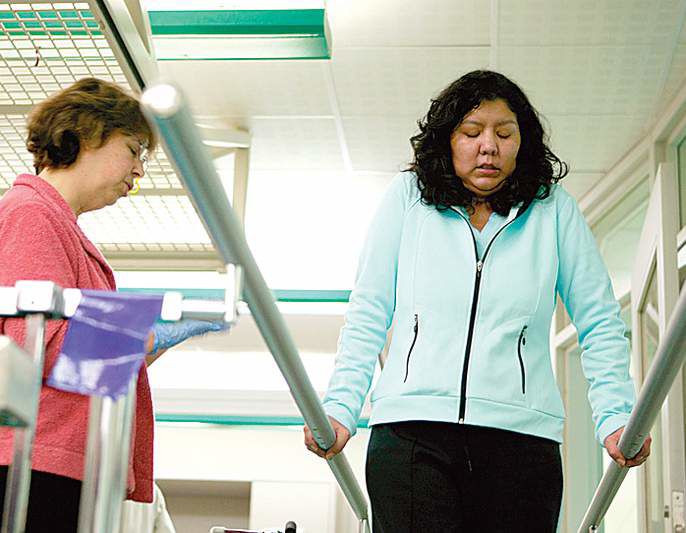Back from the brink of death from swine flu
Published 4:00 am Monday, February 1, 2010

- Lisa Amoruso, 40, right, is aided by physical therapist Carol Gleason during rehab at the Rehabilitation Institute of Chicago after a near-fatal bout of H1N1.
CHICAGO — After trying for five days to shake “a little cold,” Lisa Amoruso went to the doctor in early November. She complained of chills, aches, fatigue, fever spikes and labored breathing.
Dr. Jeffrey Nekomoto, her internist, suspected she had swine flu, but the 40-year-old effervescent mother of two from Bridgeport, Ill., didn’t seem that sick. She was talking and joking with him as he measured the oxygen in her blood.
“His eyes opened up wide, almost bulged out,” said Joe Amoruso, 50, her husband. “He said her blood oxygenation was way too low and that she had to go to an emergency room. Right away. Right now.”
Though health experts had been warning for months of the H1N1 flu pandemic, Lisa Amoruso had been among those who decided the swine flu vaccine was too risky for her family. Suddenly she was in Rush University Medical Center’s intensive care unit, on the verge of becoming one of an estimated 11,000 Americans to die from the virus over the last year.
She was hooked up to a ventilator to keep her breathing and to a dialysis machine for her failing kidneys. Then, to keep her absolutely still, her doctors put her into an induced paralytic coma.
The ordeal, which continues despite Amoruso’s emotional homecoming two weeks ago, was devastating for her family and friends. For weeks, Joe Amoruso, an insurance broker, would be driven to tears repeatedly. As much as he prayed for his wife of 14 years to live, he was frightened that the powerful treatments needed to keep her breathing would leave her in a vegetative state.
Swift descent from healthy to near death
Doctors say what happened to Lisa Amoruso should be a cautionary tale about how swiftly swine flu can turn lethal. The virus has been in retreat since peaking in November, but it continues to hospitalize people, still killing some.
While relatively mild in most cases, the H1N1 virus has differed from the seasonal flu by aggressively targeting younger, otherwise healthy children and adults, like Amoruso, rather than the elderly. Concerned about another wintertime spike, medical experts continue to urge the public to be vaccinated.
“One day (Lisa Amoruso) is this vibrant, active 40-year-old mother. The next day you get a call that she is all of a sudden so sick that she’s near death,” said Leslie Kish, Amoruso’s best friend. “How can this happen?”
Dr. Omar Lateef, director of Rush’s intensive care unit, said Amoruso’s own immune system was killing her by the time she was brought in Nov. 2. The immune system in younger, healthier people sometimes goes into overdrive, producing cells to destroy the virus and unable to turn itself off, he explained. The immune cells start destroying the patient’s own lung tissue, and other vital organs shut down.
“This was new to all of us,” Lateef said. “That first night Lisa was here, I had to tell her husband that she was the sickest person in the hospital at that moment, and that I couldn’t tell him how things might go. She was so susceptible to full-blown organ failure that out of 45 days here, 35 of them she could have died.”
A harrowing ordeal
After a week of breathing on the ventilator, it was no longer sufficient. So Lateef’s team decided to try a high frequency oscillator, a device designed to help lung-impaired infants take hundreds of weak, shallow breaths a minute. The manufacturer rushed delivery of one of the devices for Amoruso, and Lateef’s team hooked her to it Nov. 8.
It worked, but only for a week. On Sunday, Nov. 15, doctors said they were putting her back on a standard ventilator the next day.
Crestfallen, Joe Amoruso agreed but told doctors he was worried that keeping her in a coma might leave his wife with permanent brain damage.
“I needed to know if I would get my wife back if we kept going through all this,” he said, asking the doctors to try to revive her enough to determine her cognitive ability. They agreed, immediately easing off the paralytic drugs used to make her comatose.
The next day, Nov. 16, Joe Amoruso was so worried that he kept his kids out of school. For the first time, he let Juliana, an eighth-grader, come see her mother, in case it was her last chance.
“Juliana was the bravest I have ever seen her that day,” Joe Amoruso said. She stood by her unconscious mother, repeatedly telling her, “You can do this, mom.”
An hour and a half later, doctors replaced the oscillator with a standard ventilator, and it worked. But for the next few days nothing else changed, nor did Amoruso wake up.
Ten days later, at 3 a.m. Thanksgiving morning, doctors prodded her husband awake. She had taken another turn for the worse. Her right lung had developed an embolism and they needed to drain it.
The procedure went uneventfully, and at 10:30 Thanksgiving night Joe Amoruso was chatting with relatives as he gathered blankets for another night in the waiting room. A nurse walked in and told them Lisa Amoruso’s eyes were wide open, and they all rushed to her room.
“The nurse started talking to Lisa, and said, ‘If you can hear me, blink twice,’” he recounted. “Lisa blinked twice. She told Lisa to cough, and Lisa coughed. I just stood there crying. ‘I didn’t know you were here,’ I kept telling her. Everybody there, we all knew we had her back.”
‘Get vaccinated’
On Jan. 16, Lisa Amoruso finally returned to her Bridgeport home, walking up the front steps on her own into a small reception party. She will continue in-home physical therapy, but doctors tell her she will recover 100 percent.
For her, the ordeal is a blank except for foggy memories of weeping relatives and friends happy to see her alive. She said she regrets one thing — deciding last fall not to have herself, her husband or her kids vaccinated.
“Now I have told them all to get vaccinated,” she said. “I tell everybody that.”






